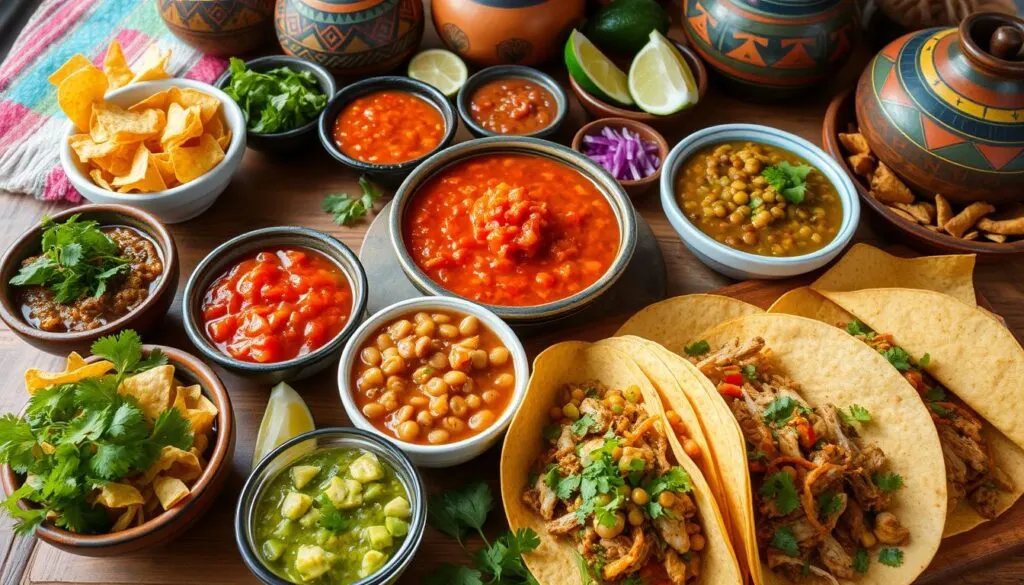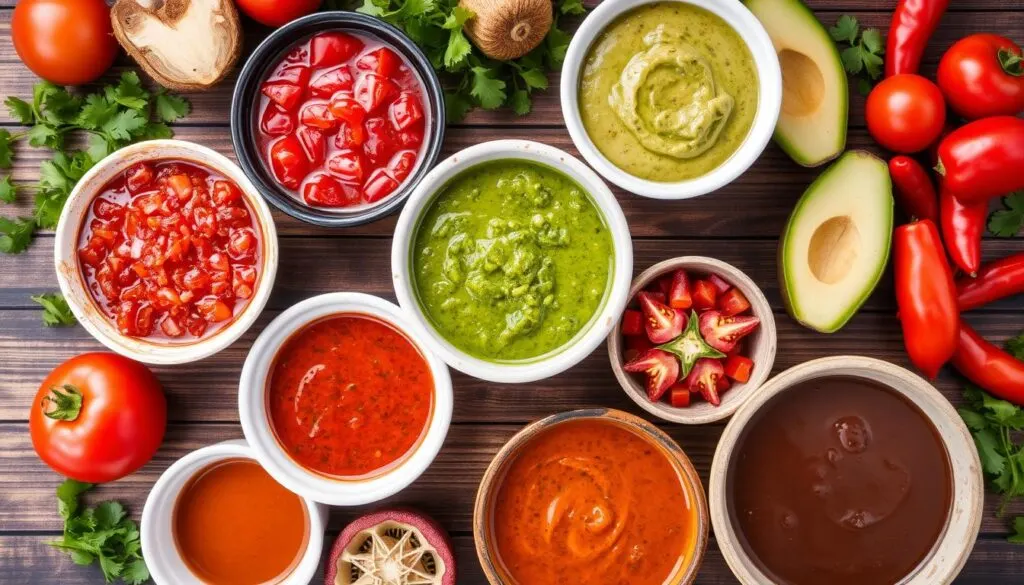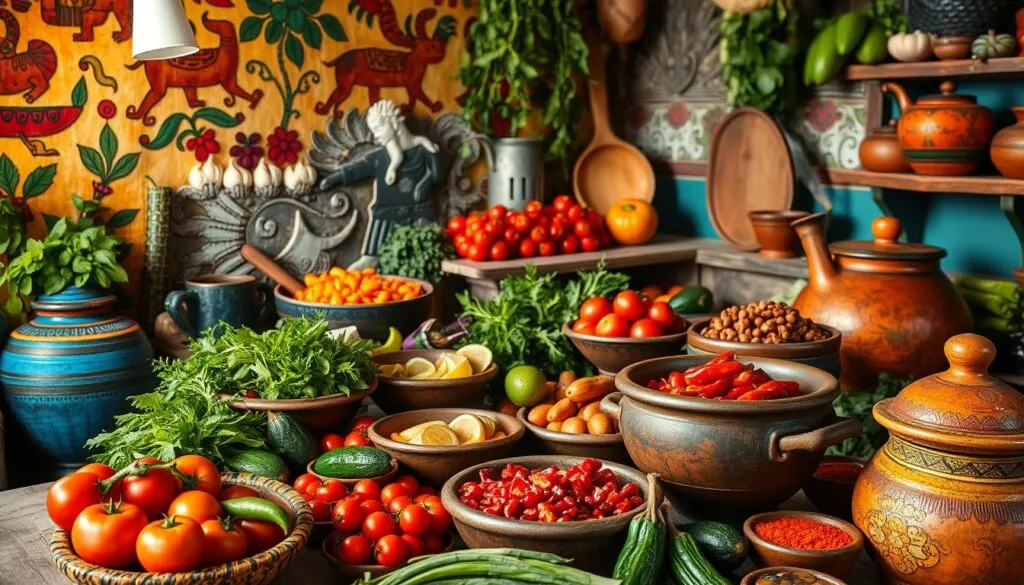I love Mexican food for its rich flavors. From mole’s smoky taste to salsa’s tangy freshness, Mexican sauces and condiments are key. But, Is Mexican Sauce the Same as Salsa?

In this guide, we’ll explore the differences between Mexican sauces and salsas. We’ll look at their history, ingredients, and uses. Whether you cook at home or just love Mexican food, you’ll learn to appreciate these culinary wonders.
Key Takeaways
- Mexican sauces and salsas are distinct culinary creations, each with their own unique ingredients, preparation methods, and uses.
- Salsas are typically fresh, uncooked condiments, while Mexican sauces often involve a more complex, cooked preparation.
- The history and cultural significance of Mexican sauces and salsas date back centuries, shaped by indigenous Mesoamerican traditions and the influence of Spanish colonization.
- Mastering the art of Mexican sauces and salsas can elevate your home cooking, allowing you to recreate the bold, authentic flavors of this beloved cuisine.
- Exploring the regional variations of Mexican sauces and salsas can provide a deeper understanding of the country’s diverse culinary landscape.
Understanding Mexican Sauces and Salsas: Basic Differences
In Mexican cuisine, salsas and sauces are often mixed up, but they’re really different. Both are key parts of Mexican cooking. Knowing the main differences between them can make you enjoy Mexican flavors more.
Traditional Mexican Sauce Categories
Mexican sauces fall into a few main groups. Each group has its own special taste and use:
- Mole sauces: Rich, complex blends of chili peppers, nuts, spices, and sometimes chocolate
- Enchilada sauces: Typically tomato-based with a spicy kick
- Tomatillo-based sauces: Tangy, green sauces made from the tomatillo fruit
- Creamy white sauces: Smooth, dairy-based sauces, often with an addition of nuts or seeds
What Defines a Salsa
Salsas, on the other hand, are fresh, uncooked condiments. They’re best served at room temperature or chilled. Salsas mix chopped or blended fresh ingredients like tomatoes, onions, chili peppers, cilantro, and lime juice.
Key Preparation Methods
The main difference in making them is the cooking method. Sauces simmer or sauté to get deeper flavors. Salsas just mix fresh ingredients without cooking.

Knowing the differences between Mexican sauces and salsas helps you enjoy the rich flavors of this tradition more.
The Historical Origins of Mexican Sauces and Salsas
Mexican cuisine is known for its bold flavors and rich history. At its core are the famous sauces and salsas that delight people everywhere. To understand these condiments fully, we must explore their origins.
The history of Mexican sauces and salsas starts with the Aztecs and Mayans. They made tasty condiments for their main dishes. These early recipes mixed chili peppers, tomatoes, onions, and spices. This mix is the base of Mexican cuisine history and traditional recipes.
When the Spanish conquistadors arrived in the 16th century, they found these cooking traditions. They brought new ingredients and methods. This added to the sauces and salsas’ flavors, creating a rich mix of tastes.
“The history of Mexican sauces and salsas is a testament to the resilience and creativity of the country’s culinary legacy, blending ancient techniques with modern innovations to create a truly remarkable and diverse array of flavors.”
From Oaxaca’s spicy mole to central Mexico’s tangy salsa verde, each area has its own sauce. This shows Mexico’s cultural and geographical diversity. It also shows the people’s love for their food traditions.

Exploring Mexican sauces and salsas reveals a world of flavors. These flavors tell the story of Mexico’s culinary journey. From ancient times to today, these condiments enchant food lovers everywhere.
Is Mexican Sauce the Same as Salsa?
Mexican sauces and salsas share some ingredients and roots. Yet, they are different in many ways. Knowing their differences can make you enjoy these Latin American flavors more.
Texture and Consistency Differences
Mexican sauces are smooth and even, thanks to blending or simmering. Salsas, however, are chunky. They have a mix of diced veggies and herbs.
Cooking Methods Comparison
Mexican sauces are cooked for a long time. This makes their flavors rich. Salsas, though, are made with raw or lightly cooked ingredients. They keep a fresh taste.
Serving Temperature Variations
Mexican sauces are warm or at room temperature. They go well with other dishes. Salsas, though, are chilled. They add a cool touch to meals.
| Characteristic | Mexican Sauce | Salsa |
|---|---|---|
| Texture | Smooth and uniform | Chunky and varied |
| Cooking Method | Simmered or roasted | Raw or minimally cooked |
| Serving Temperature | Warm or room temperature | Chilled |
At first, Mexican sauce and salsa might seem alike. But they have their own special qualities. Knowing these differences can make you love Mexican food even more.
Essential Ingredients in Mexican Sauces
Making authentic Mexican sauces starts with choosing the right ingredients. From tomato-based sauces to herb-infused ones, each part is crucial. Let’s look at the key ingredients that make these sauces so beloved.
Tomatoes are at the heart of many Mexican sauce ingredients. They’re used in sauces like enchiladas and green tomatillo sauces. The right tomatoes give a fresh, tangy taste. Chili peppers add spice, from mild to hot.
Other ingredients add depth to Mexican sauces. Herbs like cilantro, oregano, and epazote bring a fragrant touch. Onions, garlic, and spices like cumin and cloves add savory notes. These all work together to create a flavorful mix.
Some sauces also include nuts, dried fruits, and even chocolate. This mix shows how Mexican sauces can be both diverse and delicious. It’s what makes them so special.
Want to make a mole sauce or a salsa verde? Knowing the key ingredients is the first step. It helps you understand the rich flavors of these sauces.
Common Types of Mexican Salsas
Mexican cuisine is known for its vibrant and flavorful salsas. Each type offers a unique taste experience. The variety of salsas shows the rich culinary heritage of Mexico.
Fresh Salsas (Salsa Cruda)
Fresh salsas are a staple in Mexican homes and restaurants. They mix diced salsa ingredients like tomatoes, onions, chili peppers, cilantro, and lime juice. These salsas add bright, tangy flavors to many Mexican dishes.
Cooked Salsas
Cooked salsas are different from fresh ones. They simmer or roast the salsa varieties to get a deeper flavor. Roasted vegetables add a smoky taste to these salsas.
Specialty Regional Salsas
- Salsa Macha: A unique Oaxacan specialty made with toasted chili peppers, garlic, peanuts, and sesame seeds.
- Salsa Tomatillo: A tangy green salsa made with tomatillos, onions, cilantro, and lime juice, popular in central Mexico.
- Salsa Roja: A classic red salsa found throughout Mexico, made with roasted tomatoes, chili peppers, and a blend of spices.
The diverse salsa varieties in Mexican cuisine show the country’s culinary creativity. Each salsa has its own flavor, perfect for different dishes.
How to Use Mexican Sauces in Cooking
Mexican sauces can make any dish better. They add bold flavors and vibrant colors. You can use them to marinate, braise, or as a finishing touch. Explore how to use Mexican sauce uses and cooking with sauces in your kitchen.
Marinating and Braising
Mexican sauces are great for marinating. They tenderize meats, poultry, and veggies with their flavors. Just mix the sauce with your ingredients and let them soak for a while.
Braising is another great use for these sauces. It makes proteins or veggies tender and flavorful. The sauce thickens, creating a rich, velvety texture.
Finishing Touches
Mexican sauces are also perfect as a finishing touch. Try drizzling salsa on tacos or burritos for a burst of flavor. Or mix a creamy sauce into rice or beans for a Mexican twist. The options are endless with cooking with sauces.
| Sauce Pairing | Dish Recommendation |
|---|---|
| Salsa Verde | Grilled fish, chicken enchiladas, breakfast tacos |
| Mole Sauce | Roasted chicken, beef tacos, tamales |
| Guacamole | Nachos, tostadas, quesadillas |
Bring Mexican flavors into your cooking with these sauces. Use them for marinating, braising, or as a finishing touch. Mexican sauce uses will take your dishes to the next level.
Popular Salsa Varieties and Their Uses
Salsa is a key part of Mexican cuisine, adding flavor to many dishes. It ranges from classic table salsas to cooking salsas and unique regional specialties. The variety is truly impressive.
Table Salsas
Table salsas are a staple in Mexican cuisine. They’re great with main dishes or as a dip for tortilla chips. Made with tomatoes, onions, chili peppers, cilantro, and lime juice, they enhance tacos, enchiladas, and more.
Cooking Salsas
Cooking salsas are made to handle kitchen heat. They’re simmered or roasted to concentrate their flavors. Authentic recipes often include tomatillos, garlic, and spices for cooking.
Specialty Salsas
Mexican cuisine also has specialty salsas. These show off regional flavors and unique tastes. From smoky Oaxacan salsas to fruit-infused Yucatan salsas, they add complexity to traditional dishes.
Exploring salsa can enhance your cooking and dining. It opens up a world of flavors from different regions of Mexico.
Making Authentic Mexican Sauces at Home
Do you love the bold, vibrant flavors of Mexican sauces? You don’t need to buy them to enjoy Mexico’s true tastes at home. With a few easy steps, you can make your own Mexican sauces that taste just like the real thing.
The key to making great homemade Mexican sauces is using the right ingredients and techniques. First, find authentic recipes that show off Mexico’s diverse flavors. From smoky adobo to tangy tomatillo, each sauce has its own special taste.
- Roast or char your main ingredients, like tomatoes, chili peppers, and onions, to get deeper flavors.
- Blend or purée the roasted ingredients to get the texture you want, whether smooth or chunky.
- Simmer the sauce with spices, herbs, and a bit of acid, like lime juice or vinegar, to balance the taste.
- Season to your liking, adding more heat, acidity, or sweetness if needed.
With a bit of practice and trying new things, you’ll make homemade Mexican sauces that are as good as any restaurant’s. Use them with your favorite Mexican dishes or as a tasty condiment to add authentic flavor to your meals.
“Cooking authentic Mexican sauces at home allows you to explore the rich diversity of flavors that define this vibrant cuisine.”
Regional Mexican Sauce Variations
Mexico’s regional cuisine offers a wide range of flavorful sauces. These sauces reflect the country’s rich culinary history. From the bold flavors of Northern Mexico to the tangy coastal specialties, each region has its own sauce traditions.
These traditions add depth and complexity to regional Mexican cuisine and spicy foods.
Northern Mexican Sauces
In Northern Mexico, sauces are bold and smoky. They often use dried chili peppers like chipotle, ancho, and guajillo. These sauces coat grilled or roasted meats, adding a savory flavor.
One famous sauce is salsa macha. It’s creamy, spicy, and made with dried chiles, garlic, and pumpkin seeds.
Central Mexican Specialties
The central region of Mexico is known for its complex sauces. These sauces blend fresh and dried chili peppers. The classic mole sauce is a great example.
Made with spices, nuts, and toasted chiles, mole sauce is rich and velvety.
Coastal Sauce Traditions
Coastal Mexico’s sauces are bright and acidic. They reflect the area’s fresh seafood and local ingredients. Salsa verde is a key coastal sauce.
Made with tomatillos, cilantro, and green chiles, it’s perfect with grilled fish and shrimp.
Exploring Mexican sauces is a journey through the country’s culinary heritage. It shows the creativity and unique flavors of regional Mexican cuisine and spicy foods.
Storage and Shelf Life Tips
Keeping your homemade Mexican sauces and salsas fresh is key. Whether you’re making a spicy salsa or a complex mole sauce, the right storage is important. It helps keep your dishes tasting great for longer.
Here are some tips to help you store your sauces and salsas well:
- Put sauces and salsas in airtight containers right after you make them. This stops air from getting in and ruining the taste.
- For fresh salsas, try to eat them in 3-5 days for the best taste. Cooked sauces can stay in the fridge for 5-7 days.
- Freezing is a great way to keep them longer. Put your sauces and salsas in containers or bags made for the freezer. Leave some space for them to expand when they freeze. Frozen items can last 2-3 months without losing much quality.
- When you thaw frozen sauces, let them thaw in the fridge overnight. Then, warm them up slowly on the stovetop or in the microwave. Avoid sudden changes in temperature to keep the texture and taste good.
By using these storage and shelf life tips, you can enjoy your homemade Mexican dishes for longer. This makes all your kitchen work worth it.
Pairing Mexican Sauces and Salsas with Dishes
Improving your Mexican meal starts with learning to pair sauces and salsas right. These colorful toppings can turn a basic meal into a flavorful journey. They make your food taste better and look great on your plate.
For Mexican food pairings, knowing each sauce and salsa is key. A mole brings smoky flavors, while salsa verde adds a fresh zing. Each one can either match or contrast with your main dish.
| Sauce/Salsa | Recommended Pairings |
|---|---|
| Salsa Roja (Red Salsa) | Tacos, Enchiladas, Tostadas, Grilled Meats |
| Salsa Verde (Green Salsa) | Fish, Chicken, Eggs, Rice and Beans |
| Mole Sauce | Chicken, Beef, Vegetables, Rice |
| Pico de Gallo | Tacos, Nachos, Grilled or Fried Fish |
Remember, the secret to sauce combinations is to try new things. Don’t hesitate to explore different Mexican sauces and salsas. You might find your new favorites and open up a world of tastes.
“Sauces and salsas are the heart and soul of Mexican cuisine. They can transform a simple dish into a culinary masterpiece.”
By learning about Mexican sauce and salsa pairings, you can make your Mexican dishes at home even better. You’ll impress your guests with your cooking skills.
Conclusion
Mexican sauces and salsas are not the same, despite what you might think. Salsas are fresh and bright, perfect for eating at room temperature. On the other hand, Mexican sauces are richer and more complex, thanks to long cooking times.
Whether you’re enjoying a zesty salsa cruda or a smooth mole, these condiments can make your Mexican dishes better. Try out different types of Mexican sauces and salsas to see what you like best. They can really enhance your Mexican food experience.
Knowing the difference between these two key ingredients will help you use them better in your cooking. You’ll add more flavor and authenticity to your Mexican meals. So, go ahead, explore the world of Mexican sauces and salsas. Let your taste buds lead the way on this tasty adventure.
Related : Authentic Mexican Hot Sauce Recipe – Easy Homemade Salsa
FAQ
What is the difference between Mexican sauce and salsa?
Mexican sauces and salsas are different in ingredients and how they’re made. Sauces are thicker and cooked, while salsas are fresh and chunky.
What are the main ingredients in Mexican sauces?
Mexican sauces start with tomatoes or chili peppers. They add spices, herbs, and other tasty ingredients. Onions, garlic, cumin, oregano, and chili peppers are common.
What are the different types of Mexican salsas?
There are fresh, cooked, and regional salsas. Fresh salsas have tomatoes, onions, peppers, and cilantro. Cooked salsas are made by roasting or simmering ingredients.
How do you make authentic Mexican sauces at home?
Use fresh, quality ingredients and traditional methods. Roast, blend, and simmer to get the right taste and texture. Try different peppers and spices to get the Mexican flavor right.
How do you pair Mexican sauces and salsas with dishes?
Use sauces for marinating, braising, or as a final touch. Salsas are great as condiments, cooking ingredients, or with tacos and enchiladas.
How do you store and preserve Mexican sauces and salsas?
Keep them fresh by storing properly. Refrigerate fresh salsas for a few days. Cooked sauces can last a week in the fridge or longer in the freezer. Always check for spoilage before eating.
